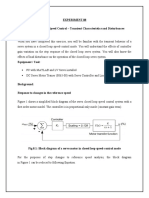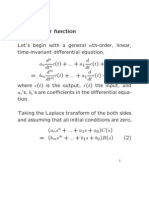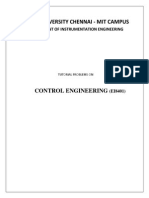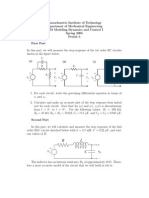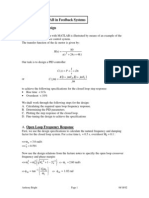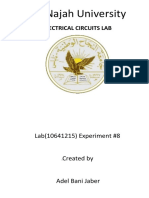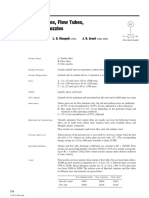Phase Lead Compensator Design Project Mauricio Oñoro: Figure 1 Circuit To Be Controlled
Uploaded by
Mauricio OñoroPhase Lead Compensator Design Project Mauricio Oñoro: Figure 1 Circuit To Be Controlled
Uploaded by
Mauricio OñoroPhase Lead Compensator Design Project
Mauricio Oñoro
Introduction
Phase lead compensation is an important and reliable method for classical control
systems. Single phase lead compensators consist of a single stable real-axis zero to the right
of a single stable real-axis pole. A phase-lead compensator is used to increase the phase
margin and stability of a system. This is designed using the root-locus method assuming
unity feedback. The purpose of this project is to introduce students to control system
design. The following report will include all the calculations, MATLAB simulations and
design put into the phase lead compensator.
Theory
The circuit to be controlled is a four-amplifier circuit with two RC Networks in
between amplifiers. This circuit is built to simulate the process to be controlled. The circuit
includes an inverter, integrator, RC network, and a voltage follower. Figure 1 displays the
circuit.
Figure 1 Circuit to be Controlled
Note how an RC network is followed by a voltage follower. The inverter is used to
get a positive transfer function. The integrator produces an output voltage which is
proportional to the integral of the input voltage. The RC network filters the signals by
blocking some frequencies and allowing others to pass through it. The voltage follower
strengthens a signal and allows a high-impedance source to drive a low-impedance load.
V o ( s)
G(s) =
V i1 ( s)
The following specifications are given: Settling time: Ts (5%) (< but ) 0.15s
Percentage overshoot: P.O. (< but )10%. The following Figure shows a preliminary
circuit for the phase lead.
Figure 2 Preliminary Circuit
Modeling Process
The first thing to be calculated is the overall transfer function for the circuit on
Figure 1. Equation one is used to calculate the transfer function of each component of the
circuit. The overall transfer function is calculated by multiplying all the individual transfer
functions.
V o ( s) −R12
The inverter calculation goes as following: T 1( s)= ( )
V 1 ( s)
=
R11
10 kΩ
¿− =−1
10 kΩ
1
−
Integrator calculation: sC −1 1
T 2( s)= = × =¿
R RC s
−1 1 −96.712
¿ × =
( 4.7 kΩ)(2.2 μF) s s
1 1 1
RC RC RC 1
First Voltage Follower calculation: T 3 (s)= = + = +1
1 s 1 RC ( s)
s+
RC RC
1 1 45.454
T 3 ( s) = = =
( 10 kΩ ) ( 2.2 μF )( s )+1 0.022 s +1 s+ 45.454
Second Voltage Follower:
1 1 1
RC RC RC 1
T 4 ( s )= = + = +1
1 s 1 RC ( s )
s+
RC RC
1 1 137.74
T 4 ( s )= = =
( 3.3 kΩ )( 2.2 μF ) ( s ) +1 0.00726 s+1 s+137.74
Equation 1 is used, and all the previous transfer functions are multiplied to obtain
the overall transfer function.
V o ( s)
G(s) = T 1 ( s ) ×T 2 ( s ) ×T 3 ( s ) ×T 4 ( s )
V i1 ( s) = T(s) =
96.712 45.454 137.75 605541.733
= (−1)×− × × =
s s+ 45.454 s+ 137.75 s ( s+ 45.454 ) (s+ 137.75)
605541.733
G(s) =
s + 183.204 s 2+ 6261.288 s
3
MATLAB Simulation for Uncompensated Circuit
Using MATLAB, a graph with insight about the circuit is generated. The graph
displays the percent overshoot and settling time. The following Figures show the results of
the simulation.
Figure 3 Simulation Code
Figure 4 MATLAB Results
As seen on the previous Figure, the percentage overshoot for this system is 61.8%
while the settling time is 0.488. The requirements for this project are to have a settling time
of 0.5 seconds and a percentage overshoot of 10%. The following sections of this report
will describe the implementation of the phase-lead to compensate the system.
Controller Implementation
Using the root-locus method and assuming unity feedback, the following
calculations are made to determine all the values needed for the controller. The last lecture
was a vital part of understanding how these values work and how they change. After many
iterations, the poles came up to be 25.92 and 55.878.
Figure 5 Detailed Calculations
As seen on the calculations, Kc is less than one so an inverting amplifier must be used. The
voltage follower eliminates the loading effect to the compensator and the inverter makes
the gain positive.
The Figure below shows the circuit used for the phase lead controller.
Figure 6 Compensating Circuit
As seen on the calculations, the settling time and percentage overshoot fall on the range
given by the requirements. Matlab is used to confirm the accuracy of the unit feedback
response of the system. The first Figure shows the Matlab results before choosing the
resistor values and the second one is after resistors were chosen
Figure 7 Response Before Resistors
Figure 8 Response After Resistors
The values for R1, R2, R3, and R4 are 7.5KΩ, 9.1 KΩ, 33KΩ, 39KΩ, respectively.
Conclusion
This project introduced the students to the design of standard components. The
lectures about the design method were interesting, insightful, and helpful towards this
project. The most challenging part of the project is to have a good understanding of how the
values work so picking resistor values is easier.
You might also like
- M203 Operator's Manual August 2001 (AF To 11W3-9-4-1)100% (3)M203 Operator's Manual August 2001 (AF To 11W3-9-4-1)168 pages
- Elec/Tele/Phtn 4123 Electrical/Telecommunications Design Proficiency Lab2No ratings yetElec/Tele/Phtn 4123 Electrical/Telecommunications Design Proficiency Lab211 pages
- Control Systems Theory: Transfer Function of Physical Systems STB 35103100% (1)Control Systems Theory: Transfer Function of Physical Systems STB 35103108 pages
- Matlab and Simulink For Modeling and Control DC MotorNo ratings yetMatlab and Simulink For Modeling and Control DC Motor14 pages
- Control Systems Theory: Transfer Function of Physical SystemsNo ratings yetControl Systems Theory: Transfer Function of Physical Systems108 pages
- Delft: Matlab and Simulink For Modeling and ControlNo ratings yetDelft: Matlab and Simulink For Modeling and Control12 pages
- Chapter 8: Introduction To Systems Control: 8.1 System Stability From Pole-Zero Locations (S-Domain)No ratings yetChapter 8: Introduction To Systems Control: 8.1 System Stability From Pole-Zero Locations (S-Domain)47 pages
- Mathematical Modeling and Parameter Estimation of A RC CircuitNo ratings yetMathematical Modeling and Parameter Estimation of A RC Circuit11 pages
- Program For Simulation of A Continuous Stirred Tank Reactor in Matlab'S GuiNo ratings yetProgram For Simulation of A Continuous Stirred Tank Reactor in Matlab'S Gui6 pages
- 4 Direct Torque Control of Induction Motor Using SimulinkNo ratings yet4 Direct Torque Control of Induction Motor Using Simulink6 pages
- Activity 5C Impedance of RC Circuits: Series RC Circuits 5C.1 Program Outcomes (Pos) Addressed by The ActivityNo ratings yetActivity 5C Impedance of RC Circuits: Series RC Circuits 5C.1 Program Outcomes (Pos) Addressed by The Activity6 pages
- Some Past Exam Problems in Control Systems - Part 1No ratings yetSome Past Exam Problems in Control Systems - Part 15 pages
- Department of Electrical Engineering Piemr, Indore: Experiment No: 01No ratings yetDepartment of Electrical Engineering Piemr, Indore: Experiment No: 0141 pages
- Antenna Azimuth and Its Simulation by Lab View Program: School of Electrical and Electronoic EngineeringNo ratings yetAntenna Azimuth and Its Simulation by Lab View Program: School of Electrical and Electronoic Engineering25 pages
- A Triggered Monostable Blocking Oscillator: Used in Legacy Channel RepeatersNo ratings yetA Triggered Monostable Blocking Oscillator: Used in Legacy Channel Repeaters12 pages
- Methods and Algorithms For Advanced Process ControlNo ratings yetMethods and Algorithms For Advanced Process Control8 pages
- Name: Zulfiqar Ali.: Department of Electronic Engineering University of Engineering and Technology Abbottabad CampusNo ratings yetName: Zulfiqar Ali.: Department of Electronic Engineering University of Engineering and Technology Abbottabad Campus15 pages
- E102 Using MATLAB in Feedback Systems Part I. Classical Design100% (1)E102 Using MATLAB in Feedback Systems Part I. Classical Design18 pages
- Discrete Time Synergetic Control For DC-DC Converter: N M N×N N×MNo ratings yetDiscrete Time Synergetic Control For DC-DC Converter: N M N×N N×M6 pages
- An-Najah University: Electrical Circuits LabNo ratings yetAn-Najah University: Electrical Circuits Lab7 pages
- EE 42/43/100 Introduction To Digital Electronics: Review of Ch. 4-7.3 7/19/13No ratings yetEE 42/43/100 Introduction To Digital Electronics: Review of Ch. 4-7.3 7/19/1343 pages
- Modeling in The Frequency Domain: Prof. Ju-Jang LeeNo ratings yetModeling in The Frequency Domain: Prof. Ju-Jang Lee32 pages
- De_Feo(2003)_Bifurcations in the Colpitts Oscillator_From Theory to PracticeNo ratings yetDe_Feo(2003)_Bifurcations in the Colpitts Oscillator_From Theory to Practice35 pages
- Student Solutions Manual to Accompany Economic Dynamics in Discrete Time, secondeditionFrom EverandStudent Solutions Manual to Accompany Economic Dynamics in Discrete Time, secondedition4.5/5 (2)
- 3D Printed Flowmeter Based On Venturi Effect With Integrated Pressure SensorsNo ratings yet3D Printed Flowmeter Based On Venturi Effect With Integrated Pressure Sensors5 pages
- Quickstart Dx35 de en FR Es PT ZH Ja It Ru Im0044955No ratings yetQuickstart Dx35 de en FR Es PT ZH Ja It Ru Im00449552 pages
- CSE1001 - Introduction To Problem Solving and ProgrammingNo ratings yetCSE1001 - Introduction To Problem Solving and Programming3 pages
- Design For Manufacturing and Assembly of A Connecting Rod 1362031980No ratings yetDesign For Manufacturing and Assembly of A Connecting Rod 13620319807 pages
- An Alternative Cost Analysis of The PACE TrialNo ratings yetAn Alternative Cost Analysis of The PACE Trial7 pages
- What Will Happen When You Attempt To Compile and Run The Following CodeNo ratings yetWhat Will Happen When You Attempt To Compile and Run The Following Code6 pages
- Assignment of Paragraph Formatting and Character FormattingNo ratings yetAssignment of Paragraph Formatting and Character Formatting6 pages
- Player Contracts: Italy's Serie B Salary Cap: AnalysisNo ratings yetPlayer Contracts: Italy's Serie B Salary Cap: Analysis2 pages
- Chapter 2 - Discourse Analysis - Gillian Brown and YuleNo ratings yetChapter 2 - Discourse Analysis - Gillian Brown and Yule6 pages
- General Mathematics: Quarter 1 - Module 10: Intercepts, Zeroes and Asymptotes of Rational Functions100% (1)General Mathematics: Quarter 1 - Module 10: Intercepts, Zeroes and Asymptotes of Rational Functions15 pages
- Graphical Symbols Fire Protection-BS1635 1990No ratings yetGraphical Symbols Fire Protection-BS1635 199027 pages
- المواطنة الرقمية ودورها في تعزيز متطلبات الرأسمال الاجتماعي د مهدية ساطوحNo ratings yetالمواطنة الرقمية ودورها في تعزيز متطلبات الرأسمال الاجتماعي د مهدية ساطوح30 pages
- [FREE PDF sample] Using econometrics a practical guide Seventh Edition, Global Edition Studenmund ebooks100% (1)[FREE PDF sample] Using econometrics a practical guide Seventh Edition, Global Edition Studenmund ebooks52 pages
- M203 Operator's Manual August 2001 (AF To 11W3-9-4-1)M203 Operator's Manual August 2001 (AF To 11W3-9-4-1)
- Elec/Tele/Phtn 4123 Electrical/Telecommunications Design Proficiency Lab2Elec/Tele/Phtn 4123 Electrical/Telecommunications Design Proficiency Lab2
- Control Systems Theory: Transfer Function of Physical Systems STB 35103Control Systems Theory: Transfer Function of Physical Systems STB 35103
- Matlab and Simulink For Modeling and Control DC MotorMatlab and Simulink For Modeling and Control DC Motor
- Control Systems Theory: Transfer Function of Physical SystemsControl Systems Theory: Transfer Function of Physical Systems
- Delft: Matlab and Simulink For Modeling and ControlDelft: Matlab and Simulink For Modeling and Control
- Chapter 8: Introduction To Systems Control: 8.1 System Stability From Pole-Zero Locations (S-Domain)Chapter 8: Introduction To Systems Control: 8.1 System Stability From Pole-Zero Locations (S-Domain)
- Mathematical Modeling and Parameter Estimation of A RC CircuitMathematical Modeling and Parameter Estimation of A RC Circuit
- Program For Simulation of A Continuous Stirred Tank Reactor in Matlab'S GuiProgram For Simulation of A Continuous Stirred Tank Reactor in Matlab'S Gui
- 4 Direct Torque Control of Induction Motor Using Simulink4 Direct Torque Control of Induction Motor Using Simulink
- Activity 5C Impedance of RC Circuits: Series RC Circuits 5C.1 Program Outcomes (Pos) Addressed by The ActivityActivity 5C Impedance of RC Circuits: Series RC Circuits 5C.1 Program Outcomes (Pos) Addressed by The Activity
- Some Past Exam Problems in Control Systems - Part 1Some Past Exam Problems in Control Systems - Part 1
- Department of Electrical Engineering Piemr, Indore: Experiment No: 01Department of Electrical Engineering Piemr, Indore: Experiment No: 01
- Antenna Azimuth and Its Simulation by Lab View Program: School of Electrical and Electronoic EngineeringAntenna Azimuth and Its Simulation by Lab View Program: School of Electrical and Electronoic Engineering
- A Triggered Monostable Blocking Oscillator: Used in Legacy Channel RepeatersA Triggered Monostable Blocking Oscillator: Used in Legacy Channel Repeaters
- Methods and Algorithms For Advanced Process ControlMethods and Algorithms For Advanced Process Control
- Name: Zulfiqar Ali.: Department of Electronic Engineering University of Engineering and Technology Abbottabad CampusName: Zulfiqar Ali.: Department of Electronic Engineering University of Engineering and Technology Abbottabad Campus
- E102 Using MATLAB in Feedback Systems Part I. Classical DesignE102 Using MATLAB in Feedback Systems Part I. Classical Design
- Discrete Time Synergetic Control For DC-DC Converter: N M N×N N×MDiscrete Time Synergetic Control For DC-DC Converter: N M N×N N×M
- EE 42/43/100 Introduction To Digital Electronics: Review of Ch. 4-7.3 7/19/13EE 42/43/100 Introduction To Digital Electronics: Review of Ch. 4-7.3 7/19/13
- Modeling in The Frequency Domain: Prof. Ju-Jang LeeModeling in The Frequency Domain: Prof. Ju-Jang Lee
- De_Feo(2003)_Bifurcations in the Colpitts Oscillator_From Theory to PracticeDe_Feo(2003)_Bifurcations in the Colpitts Oscillator_From Theory to Practice
- Student Solutions Manual to Accompany Economic Dynamics in Discrete Time, secondeditionFrom EverandStudent Solutions Manual to Accompany Economic Dynamics in Discrete Time, secondedition
- Analog Dialogue, Volume 48, Number 1: Analog Dialogue, #13From EverandAnalog Dialogue, Volume 48, Number 1: Analog Dialogue, #13
- 3D Printed Flowmeter Based On Venturi Effect With Integrated Pressure Sensors3D Printed Flowmeter Based On Venturi Effect With Integrated Pressure Sensors
- Quickstart Dx35 de en FR Es PT ZH Ja It Ru Im0044955Quickstart Dx35 de en FR Es PT ZH Ja It Ru Im0044955
- CSE1001 - Introduction To Problem Solving and ProgrammingCSE1001 - Introduction To Problem Solving and Programming
- Design For Manufacturing and Assembly of A Connecting Rod 1362031980Design For Manufacturing and Assembly of A Connecting Rod 1362031980
- What Will Happen When You Attempt To Compile and Run The Following CodeWhat Will Happen When You Attempt To Compile and Run The Following Code
- Assignment of Paragraph Formatting and Character FormattingAssignment of Paragraph Formatting and Character Formatting
- Player Contracts: Italy's Serie B Salary Cap: AnalysisPlayer Contracts: Italy's Serie B Salary Cap: Analysis
- Chapter 2 - Discourse Analysis - Gillian Brown and YuleChapter 2 - Discourse Analysis - Gillian Brown and Yule
- General Mathematics: Quarter 1 - Module 10: Intercepts, Zeroes and Asymptotes of Rational FunctionsGeneral Mathematics: Quarter 1 - Module 10: Intercepts, Zeroes and Asymptotes of Rational Functions
- المواطنة الرقمية ودورها في تعزيز متطلبات الرأسمال الاجتماعي د مهدية ساطوحالمواطنة الرقمية ودورها في تعزيز متطلبات الرأسمال الاجتماعي د مهدية ساطوح
- [FREE PDF sample] Using econometrics a practical guide Seventh Edition, Global Edition Studenmund ebooks[FREE PDF sample] Using econometrics a practical guide Seventh Edition, Global Edition Studenmund ebooks










